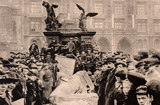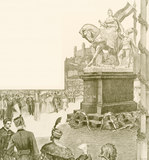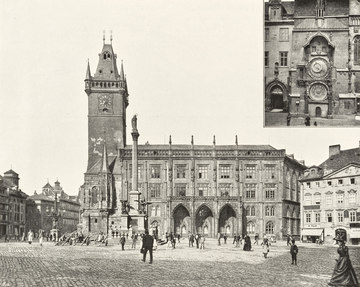The Fall of the Symbols of Habsburg Rule
-

The toppled Column of the Virgin on the Prague Old Town Ring, newspaper photo from Das Interessante Blatt, issue of 14 November 1918
Copyright: ÖNB/ANNO
Partner: Austrian National Library -

Viktor Halmi: Unveiling of the Maria Theresa monument in Pressburg/Bratislava, 1897, drawing, 1908
Copyright: Schloß Schönbrunn Kultur-und Betriebsges.m.b.H./Fotograf: Alexander E. Koller
The destruction of symbols of foreign domination – including the Column of the Virgin Mary in Prague and the Maria-Theresa Monument in Bratislava – gave expression to a sense of victory over national suppression and of newly achieved independence. But another interesting aspect of these actions is the “afterlife” of these historical monuments and the public treatment of them in the years after 1989.
The Column of the Virgin Mary on Prague’s Old Town Square was endowed by Emperor Ferdinand III in thanksgiving for the successful defence of the historical part of the city of Prague against the Swedish Army in 1648. In the nineteenth century a national Czech view of history was evolving, the Catholic Counter-Reformation was condemned as a “Dark Age” (Czech temno), and nationalist polemics interpreted the Baroque column as a particularly painful symbol of Habsburg tyranny in the heart of Prague. In 1915 an imposing monument to Jan Hus was erected opposite the Column of the Virgin Mary – so to speak as an ideological polarity.
On 3 November 1918, a rioting crowd led by several nationalist agitators pulled down the column as a sign of “national liberation” in the course of setting up the independent Czechoslovakian Republic
In 1990, after the end of the Communist regime, a society was formed for re-erecting the monument. It was planned to install a replica incorporating the preserved fragments on the original location. This sparked off a protracted and still incessant discussion about the treatment of history. A mark on the pavement placed in 1993 commemorates the site. The final decision about the reinstallation of the column is still to be made.
In Slovakia there was also a case of anti-Habsburg iconoclasm, even if the situation in pulling down the Maria-Theresa Monument in Bratislava had a different significance.
The monument to the Habsburg empress stood on today’s Námestie Ľudovíta Štúra, a very prominent square on the bank of the Danube. The city on the Danube, once the scene in the eighteenth century for staging coronations of the Hungarian kings, heaped up a coronation hill on this spot using soil from all parts of the kingdom. The ceremony required the freshly crowned monarch to mount his horse and ride up the hill wielding the sword of St Stephen, symbolically driving out the enemies of the nation. Maria Theresa, too, submitted to this custom as a young ruler in 1741.
The monument, however, is a work of the late nineteenth century and commissioned in 1896 by the Pressburg (Bratislava) municipality as part of the Hungarian “millennium celebrations”. The monument of white Carrara marble showed the queen mounted high on her horse flanked by a Hungarian magnate in opulent national dress expansively gesturing in the direction of the Danube, offering the country to the empress queen.
The symbolism of the monument evoked a Hungarian historical myth: the inscription on the base “VITAM ET SANGUINEM” (Life and Blood) alludes to the legendary Hungarian state diet of 1741, in which the Hungarian estates promised their aid to Maria Theresa – urgently needed by the young Habsburg empress queen, who was fighting for her right of succession. This was a key moment for the pro-Habsburg version of the “patriotic” view of history in Hungary.
After the downfall of the historic Kingdom of Hungary, Pozsony/Pressburg/Prešborok became a part of Czechoslovakia. The renaming of the city as Bratislava marked a turning point. But neither the founding of the Republic in October 1918, nor the final assertion of post-war order as the result of the Paris Suburb Contracts brought the end of the historically charged statue.
This only happened as reaction to the second attempt to restore the deposed Habsburg Karl I (as the Hungarian King Károly IV) in autumn 1921. It led to a mobilisation of the Czechoslovakian Army, since a restoration of Habsburg rule in Hungary was seen as an endangerment to the existence of the new Czechoslovakian Republic. On 26 October 1921, in a moment of nationalist frenzy, the legionaries, now ready for combat, vented their emotions on the statue.
A new monument was erected here in 1937, this time dedicated to Milan Rastislav Štefánik, a Slovakian founding father of Czechoslovakia. It was not long before Štefánik had to vacate his post; in 1940 a memorial to the joint nation with the Czechs was not opportune in Fascist Slovakia. The Communists adorned the site in 1960 with a monument to the national revivers of the Slovaks in the nineteenth century. Finally, in October 2010, a smaller version of the Maria-Theresa Monument was installed on the bank of the Danube, but not without agitating a heated discussion in the media.
Translation: Abigail Prohaska
Hojda, Zdeněk: Mladá panovnice se chce vrátit na místo své korunovace (dt.: Die junge Herrscherin möchte auf den Platz ihrer Krönung zurückkehren), in: Dějiny a současnost 4, 2012, S. 12
http://www.marianskysloup.cz/clanky/novinove-clanky.html (Homepage der Gesellschaft für die Erneuerung der Mariensäule am Altstädter Ring in Prag/Společnost pro obnovu Mariánského sloupu na Staroměstském náměstí v Praze; Abfragedatum: 05.04.2014)
http://praha.idnes.cz/na-staromestske-namesti-v-praze-se-vrati-mariansky-sloup-mozna-i-kasna-1mo-/praha-zpravy.aspx?c=A120512_1777133_praha-zpravy_sfo (Abfragedatum: 05.04.2014)
-
Chapters
- Delenda Austria – Austria must be destroyed!
- The aim of state independence: from Utopia to a programme for the masses
- Preparing for the Coup
- The Day of the Coup: 28 October 1918
- The Founding of Czechoslovakia
- The Czechoslovakian Republic as Successor State to Austria-Hungary
- The Czechoslovakian Legions
- The Fall of the Symbols of Habsburg Rule



